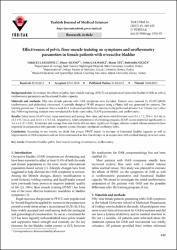| dc.contributor.author | Kulaksızoğlu, Haluk | |
| dc.contributor.author | Akand, Murat | |
| dc.contributor.author | Çakmakçı, Evrim | |
| dc.contributor.author | Gül, Murat | |
| dc.contributor.author | Seçkin, Bedreddin | |
| dc.date.accessioned | 2016-03-30T14:05:21Z | |
| dc.date.available | 2016-03-30T14:05:21Z | |
| dc.date.issued | 2015 | |
| dc.identifier.citation | Kulaksizoğlu H, Akand M, Çakmakçi E, Gül M, Seçkin B. Effectiveness of pelvic floor muscle training on symptoms and uroflowmetry parameters in female patients with overactive bladder. Turk J Med Sci. 2015;45(2):449-453. doi:10.3906/sag-1310-95 | en_US |
| dc.identifier.issn | 1300-0144 | |
| dc.identifier.uri | http://journals.tubitak.gov.tr/medical/index.php | en_US |
| dc.identifier.uri | https://hdl.handle.net/11446/940 | en_US |
| dc.description | İstanbul Bilim Üniversitesi, Tıp Fakültesi. | en_US |
| dc.description.abstract | Background/aim: To evaluate the effects of pelvic floor muscle training (PFMT) on symptoms of overactive bladder (OAB) as well as uroflowmetry parameters and functional bladder capacity.
Materials and methods: Fifty-nine female patients with OAB symptoms were included. Patients were assessed by SEAPI-QMM, uroflowmetry, and abdominal ultrasound. A specially designed PFMT program using a Pilates ball was generated for patients. The training period was 1-h sessions twice a week for 6 weeks and aerobic home exercises to be performed at home 4 or 5 times every other
day. Following training, subjects were reevaluated for body mass index, SEAPI questionnaire, and uroflowmetry.
Results: Initial mean SEAPI score, mean maximum and average flow rates, and mean voided volume were 9.8 ± 7.2, 29.8 ± 16.4 mL/s, 16.3 ± 8.7 mL/s, and 211.6 ± 173.5 mL, respectively. After completion of the training program, SEAPI scores improved significantly to 3.4 ± 6.4 (P < 0.05). Maximum and average flow rate results did not show significant changes, whereas voided volume seemed to have improved in conjunction with patients’ symptom scores (Pearson correlation coefficient: 0.86).
Conclusion: According to our results, we think that proper PFMT results in increase of functional bladder capacity as well as improvement in OAB symptoms and can be recommended as first-line therapy or in conjunction with medical therapy in severe cases. | en_US |
| dc.language.iso | eng | en_US |
| dc.publisher | Türkiye Bilimsel ve Teknik Araştırma Kurumu | en_US |
| dc.identifier.doi | 10.3906/sag-1310-95 | en_US |
| dc.rights | info:eu-repo/semantics/openAccess | en_US |
| dc.subject | overactive bladder | en_US |
| dc.subject | pelvic floor muscle training | en_US |
| dc.subject | incontinence | en_US |
| dc.subject | uroflowmetry | en_US |
| dc.title | Effectiveness of pelvic floor muscle training on symptoms and uroflowmetry parameters in female patients with overactive bladder. | en_US |
| dc.type | article | en_US |
| dc.relation.journal | Turkish Journal of Medical Sciences | en_US |
| dc.department | DBÜ, Tıp Fakültesi | en_US |
| dc.identifier.issue | 2 | |
| dc.identifier.volume | 45 | |
| dc.identifier.startpage | 449 | |
| dc.identifier.endpage | 453 | |
| dc.contributor.authorID | TR119991 | en_US |
| dc.contributor.authorID | TR149781 | en_US |
| dc.contributor.authorID | TR139977 | en_US |
| dc.contributor.authorID | TR140586 | en_US |
| dc.contributor.authorID | TR144552 | en_US |
| dc.relation.publicationcategory | Belirsiz | en_US |


















